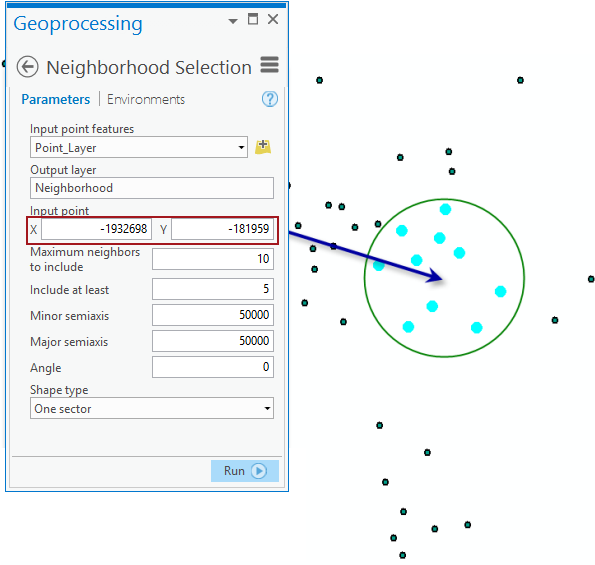| Label | Explanation | Data Type |
Input point features | The points that will be used to create a neighborhood selection. | Feature Layer |
Output layer | An output layer with the neighborhood selection. | Feature Layer |
Input point | The neighborhood center's x,y-coordinate. | Point |
Maximum neighbors to include | The number of points that will be used in each sector. If a sector has the required number of points, all points in that sector will be used. | Long |
Include at least | The minimum number of points that will be used in each sector. If the minimum number of required points are not available in any given sector, the nearest available point outside the sector will be selected. | Long |
Minor semiaxis | The size of the minor semiaxis of the search neighborhood. | Double |
Major semiaxis | The size of the major semiaxis of the search neighborhood. | Double |
Angle | The angle of rotation of the neighborhood axis. | Double |
Shape type (Optional) | Species the geometry of the neighborhood.
| String |
Available with Geostatistical Analyst license.
Summary
Creates a layer of points based on a user-defined neighborhood.
For example, you can create a selection of points in a circular neighborhood around a location defined by the input point.
Illustration

Usage
This tool can be used in conjunction with tools in the Interpolation toolset when different searching neighborhoods are examined.
Parameters
arcpy.ga.GANeighborhoodSelection(in_dataset, out_layer, point_coord, neighbors_max, neighbors_min, minor_semiaxis, major_semiaxis, angle, {shape_type})| Name | Explanation | Data Type |
in_dataset | The points that will be used to create a neighborhood selection. | Feature Layer |
out_layer | An output layer with the neighborhood selection. | Feature Layer |
point_coord | The neighborhood center's x,y-coordinate. | Point |
neighbors_max | The number of points that will be used in each sector. If a sector has the required number of points, all points in that sector will be used. | Long |
neighbors_min | The minimum number of points that will be used in each sector. If the minimum number of required points are not available in any given sector, the nearest available point outside the sector will be selected. | Long |
minor_semiaxis | The size of the minor semiaxis of the search neighborhood. | Double |
major_semiaxis | The size of the major semiaxis of the search neighborhood. | Double |
angle | The angle of rotation of the neighborhood axis. | Double |
shape_type (Optional) | Species the geometry of the neighborhood.
| String |
Code sample
Create a feature layer based on some neighborhood criteria.
import arcpy
from arcpy import env
env.workspace = "C:/gapyexamples/data"
arcpy.GANeighborhoodSelection_ga("ca_ozone_pts", "outNS", "-2000000 -50000",
"20", "5","200000", "200000", "0", "One sector")Create a feature layer based on some neighborhood criteria.
# Name: NeighborhoodSelection_Example_02.py
# Description: Creates a layer of points based on a user-defined neighborhood.
# Requirements: Geostatistical Analyst Extension
# Import system modules
import arcpy
# Set environment settings
arcpy.env.workspace = "C:/gapyexamples/data"
# Set local variables
inPoints = "ca_ozone_pts.shp"
outLayer = "outNS"
pointCoord = "-2000000 -50000"
maxNeighbors = 20
minNeighbors = 5
majSemiaxis = 200000
minSemiaxis = 200000
angle = 0
shape = "One Sector"
# Execute NeighborhoodSelection
arcpy.GANeighborhoodSelection_ga(inPoints, outLayer, pointCoord, maxNeighbors,
minNeighbors, majSemiaxis, minSemiaxis, angle,
shape)Environments
Licensing information
- Basic: Requires Geostatistical Analyst
- Standard: Requires Geostatistical Analyst
- Advanced: Requires Geostatistical Analyst